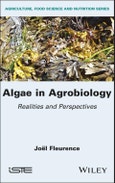Algae in Agrobiology offers a current and forward-looking account of algae use: in agriculture and in the sector of land and marine animal production, as algal extracts and molecules in the form of fertilizers or biostimulants for crops with agronomic interest, and as algal compounds in the area of plant and animal health.
This book is based on advances in biochemical and agronomic research in order to explain the conventional practices associated with the use of algae in agriculture and livestock breeding. These advances make it possible to establish possible uses for marine algal resources in the agriculture of the future.
Table of Contents
Preface vii
Introduction ix
Chapter 1. History 1
1.1. The different types of kelp 1
1.2. Historical applications 3
Chapter 2. Traditional Applications of Algae in the Cultivation Plants 11
2.1. Uses for soil amendment 11
2.2. Soil fertilization 14
2.3. Improvement of composts for agricultural use 16
Chapter 3. Biostimulation Activities on Plant Productions 23
3.1. Stimulation of growth 25
3.2. Tolerance to water stress 38
3.3. Tolerance to salt stress 45
3.4. Tolerance to thermal stress 58
3.5. The quality of the products 60
Chapter 4. Feeding of Livestock 69
4.1. Ruminant nutrition 69
4.2. Pig nutrition 80
4.3. Horse nutrition 87
4.4. Poultry nutrition 90
4.5. Nutrition of rabbits 100
4.6. Nutrition of animals produced by aquaculture 103
4.6.1. Fish 104
4.6.2. Mollusks 118
4.6.3. Crustaceans 124
4.6.4. Echinoderms 128
Chapter 5. The Biological Activities of Algae in Plant or Animal Health 135
5.1. Antiparasitic and antimicrobial activities 135
5.1.1. Plant parasites and pathogens 135
5.1.2. Animal parasites and pathogens 146
5.2. Induction of plant defense mechanisms 151
5.2.1. The hypersensitivity reaction 151
5.2.2. Other mechanisms 154
5.3. Activation of the immune system 158
5.3.1. The case of fish raised by aquaculture 158
5.3.2. Other aquaculture animals 163
5.3.3. The case of terrestrial livestock 165
Conclusion 169
References 171
Index 183








